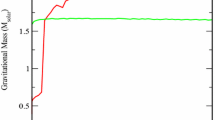Abstract
Efforts to understand unusual weather or abrupt changes in climate have been plagued by deficiencies of the standard solar model (SSM) [1]. Although it assumes that our primary source of energy began as a homogeneous ball of hydrogen (H) with a steady, well-behaved H-fusion reactor at its core, observations instead reveal a very heterogeneous, dynamic Sun. As examples, the upward acceleration and departure of H+ ions from the surface of the quiet Sun and abrupt climatic changes, including geomagnetic reversals and periodic magnetic storms that eject material from the solar surface are not explained by the SSM. The present magnetic fields are probably deep-seated remnants of very ancient origin. These could have been generated from two mechanisms. These are (1) Bose-Einstein condensation [2] of iron-rich, zero-spin material into a rotating, superfluid, superconductor surrounding the solar core and/or (2) superfluidity and quantized vortices in nucleon-paired Fermions at the core [3].
Similar content being viewed by others
REFERENCES
O. Manuel and S. Friberg, in Proceedings of 2002 SOHO 12/GONG —2002, Local and Global Helioseismology: The Present and Future (Huguette Lacoste, ed., ESA SP-517 SOHO/ GONG, Noordwijk, The Netherlands (2003) pp. 345–348.
B. W. Ninham, Physics Lett. 4, 278–279 (1963).
P. M. Pizzochero, L. Viverit, and R. A. Brogalia, Physical Rev. Lett. 79, 3347–3350 (1997).
D. L. Landau and E. M. Lifschifz, Statistical Physics, translated from Russian by J. B. Sykes and M. J. Kearsley (2nd revised and enlarged edition, Addison-Wesley, Reading, MA, 1969).
W. Baade and F. Zwicky Proc. Natl. Acad. Sci. 20, 259–263 (1934).
J. R. Oppenheimer and G. M. Volkoff, Physics Rev. 15, 374–381 (1939).
O. K. Manuel and D. D. Sabu, Science 195, 208–209 (1977).
R. V. Ballad, et al., Nature 277, 615–620 (1979).
D. D. Sabu and O. K. Manuel, Meteoritics 15, 117–138 (1980).
O. K. Manuel and G. Hwaung, Meteoritics 18, 209–222 (1983).
O. Manuel, in Origin of Elements in the Solar System: Implications of Post-1957 Observations (Proceedings of the 1999 ACS symposium organized by Glenn T. Seaborg and Oliver K. Manuel. O. Manuel, ed., Kluwer/Plenum Publishers, New York, NY, 2000) pp. 279–287.
O. Manuel, et al., J. Fusion Energy 19, 93–98 (2000).
O. Manuel, E. Miller, and A. Katragada J. Fusion Energy 20, 197–201 (2001).
O. Manuel, et al., The Sun's Origin, Composition and Source of Energy, 32nd Lunar and Planetary Science Conference, abstract 1041, Houston, TX, March 12-16, 2001, LPI Contribution 1080, ISSN No. 0161-5297 (2001).
O. Manuel, “The Standard Solar Model Versus Experimental Observations” BEYOND '2002, Third International Conference on Physics Beyond the Standard Model-Accelerator, Non-Accelerator and Space Approaches in the New Millenium. Oulu, Finland (H. V. Klapdor-Kleingrothaus, ed., IOP, Bristol, England) pp. 307–316.
T. Landscheidt, “Long-Range Forecast of U.S. Drought Based on Solar Activity” http://www.john-daly.com/solar/US-drought.htm (2003).
J. M. Herndon EOS Trans. Am. Geophys. Union 79, 451, 456 (1998).
D. F. Hollenbach and J. M. Herndon, Proc. Natl. Acad. Sci. 98, 11085–11090 (2001).
V. Bothmer, et al., Solar Syst. Res. 36, 499–506 (2002); translated from Astronomicheskii Vestnik 36, 539-547 (2002).
P. Thejll, B. Christiansen, and H. Gleisner, Geophys. Res. Lett. 30, 1347–1367 (2003).
T. Landscheidt, Solar Physics 189, 415–426 (1999).
M. J. Thompson, et al., Science 272, 1300–1305 (1996).
M. Neugebauer, E. Smith, A. Ruzmaikin, J. Feynman, and A. Vaughn J. Geophys. Res. 105, 2314–2324 (2000).
T. Corbard “The Solar Tachocline,” paper presented at the SOHO 12 /GONG — 2002 Meeting, Big Bear Lake, CA, October 27-November 1, 2002. See slide 21, image 20 http:// www. obs-nice.fr/corbard/BB_HTML/img20.html.
This quote from Dr. Marcia Neugebauer is in the eighth paragraph of a JPL news release on February 1, 2000, “The Sun's Magnetic Field Has a Good Memory,” at http://www. appliedmeditation.org/ The_Heart/cosmic_sun.html.
A. Dar and G. Shaviv, Ap. J. 468, 933–946 (1996). Assumptions of the standard solar model are given on p. 935.
O. K. Manuel and D. D. Sabu, Trans. Missouri Acad. Sci. 9, 104–122 (1975).
O. K. Manuel, Am. Scientist 85, 478–479 (1997).
A. Ruzmaikin and C. Lindsey, “Helioseismic probing of the solar dynamo flows,” in Proceedings of 2002 SOHO 12/GONG 2002, Local and Global Helioseismology: The Present and Future (H. Lacoste, ed., ESA SP-517 SOHO/GONG, Noordwijk, The Netherlands, 2003) pp. 71–75.
D. H. Hathaway, “Large-scale flows through the solar cycle, ” in Proceedings of 2002 SOHO 12/GONG 2002, Local and Global Helioseismology: The Present and Future (H. Lacoste, ed., ESA SP-517 SOHO/GONG, Noordwijk, The Netherlands, 2003) pp. 87–96.
J. Toomere, “Overview: Where do we stand with helioseismology,” in Proceedings of 2002 SOHO 12/GONG 2002, Local and Global Helioseismology: The Present and Future (Huguette Lacoste, ed., ESA SP-517 SOHO/GONG, Noordwijk, The Netherlands, 2003) pp. 3–14.
E. Zinner Science 300, 265–267 (2003).
P. K. Kuroda and W. A. Myers, Radiochim. Acta 77, 15–20 (1991).
S. Tachibana and G. R. Huss, Lunar and Planet. Sci. XXXIV, Abstract 1737 (2003).
T. Gold, Nature 218, 731–732 (1968).
T. Gold, Nature 221, 25–27 (1969).
R. Howe, et al., Science 287, 2456–2460 (2000).
R. Davis, Jr., D. S. Harmer, and K. C. Hoffman Physics Rev. Lett. 20, 1205–1209 (1968).
J. Geiss, in Origin and Evolution of the Elements (N. Prantoz, E. Vangioni-Flam, and M. Casse, eds., Cambridge University Press, Cambridge 1993) pp. 89–106.
A. Nolte and C. Lietz, in Origin of Elements in the Solar System: Implications of Post-1957 Observations (Proceedings of the 1999 ACS symposium organized by GlennT. Seaborg and Oliver K. Manuel; O. Manuel, ed., Kluwer/Plenum Publishers, New York, NY, 2000) pp. 529–543.
P. Toth, Nature 270, 159–160 (1977).
Author information
Authors and Affiliations
Rights and permissions
About this article
Cite this article
Manuel, O.K., Ninham, B.W. & Friberg, S.E. Superfluidity in the Solar Interior: Implications for Solar Eruptions and Climate. Journal of Fusion Energy 21, 193–198 (2002). https://doi.org/10.1023/A:1026250731672
Issue Date:
DOI: https://doi.org/10.1023/A:1026250731672



